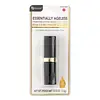B-Pure Essentially Ageless Collagen Nourishing Moisturizer Versus B-Pure Essentially Ageless Hydrating Serum Lipstick
What's inside
What's inside
 Key Ingredients
Key Ingredients

 Benefits
Benefits

 Concerns
Concerns

 Ingredients Side-by-side
Ingredients Side-by-side

Water
Skin ConditioningPolysorbate 60
EmulsifyingCetearyl Alcohol
EmollientSorbitan Stearate
EmulsifyingCera Alba
EmollientGlycerin
HumectantPEG-100 Stearate
Phenoxyethanol
PreservativeIsopropyl Myristate
EmollientEthylhexyl Palmitate
EmollientPolyacrylamide
Glyceryl Stearate
EmollientC13-14 Isoparaffin
EmollientHydroxyacetophenone
AntioxidantButyrospermum Parkii Butter
Skin ConditioningNiacinamide
SmoothingParfum
MaskingXanthan Gum
EmulsifyingLaureth-7
EmulsifyingDisodium EDTA
Tocopheryl Acetate
AntioxidantSodium Hyaluronate
HumectantAscorbic Acid
AntioxidantButyrospermum Parkii Butter Extract
Skin ConditioningButylene Glycol
HumectantSalicylic Acid
MaskingPentylene Glycol
Skin ConditioningEthylhexylglycerin
Skin Conditioning1,2-Hexanediol
Skin ConditioningCollagen
MoisturisingSorbic Acid
PreservativeWater, Polysorbate 60, Cetearyl Alcohol, Sorbitan Stearate, Cera Alba, Glycerin, PEG-100 Stearate, Phenoxyethanol, Isopropyl Myristate, Ethylhexyl Palmitate, Polyacrylamide, Glyceryl Stearate, C13-14 Isoparaffin, Hydroxyacetophenone, Butyrospermum Parkii Butter, Niacinamide, Parfum, Xanthan Gum, Laureth-7, Disodium EDTA, Tocopheryl Acetate, Sodium Hyaluronate, Ascorbic Acid, Butyrospermum Parkii Butter Extract, Butylene Glycol, Salicylic Acid, Pentylene Glycol, Ethylhexylglycerin, 1,2-Hexanediol, Collagen, Sorbic Acid
Ethylhexyl Palmitate
EmollientBeeswax
Emulsion StabilisingPolybutene
Synthetic Wax
AbrasivePolyethylene
AbrasiveOzokerite
Emulsion StabilisingPhenoxyethanol
PreservativeEthylhexylglycerin
Skin ConditioningCyclopentasiloxane
EmollientPanthenol
Skin ConditioningParaffinum Liquidum
EmollientPetrolatum
EmollientPolysorbate 80
EmulsifyingHydrogenated Styrene/Isoprene Copolymer
Silica Dimethyl Silylate
EmollientDiglyceryl Adipate/Caprate/Caprylate/Hydroxystearate/Isostearate/Stearate
EmollientDimethicone
EmollientParfum
MaskingTitanium Dioxide
Cosmetic ColorantIron Oxides
CI 15850
Cosmetic ColorantEthylhexyl Palmitate, Beeswax, Polybutene, Synthetic Wax, Polyethylene, Ozokerite, Phenoxyethanol, Ethylhexylglycerin, Cyclopentasiloxane, Panthenol, Paraffinum Liquidum, Petrolatum, Polysorbate 80, Hydrogenated Styrene/Isoprene Copolymer, Silica Dimethyl Silylate, Diglyceryl Adipate/Caprate/Caprylate/Hydroxystearate/Isostearate/Stearate, Dimethicone, Parfum, Titanium Dioxide, Iron Oxides, CI 15850
Ingredients Explained
These ingredients are found in both products.
Ingredients higher up in an ingredient list are typically present in a larger amount.
Ethylhexyl Palmitate, also known as octyl palmitate, is created from 2-ethylhexyl alcohol and palmitic acid. It is a fatty acid ester.
The fatty acid content of Ethylhexyl Palmitate makes it an emollient. Emollients help soften and hydrate your skin by trapping moisture within.
Ethylhexyl Palmitate is also used to help improve the texture of cosmetics. It helps other ingredient dissolve in products and help disperse ingredients more evenly.
You'll likely find this ingredient in sunscreen, as it is often used to mix UV-blocking ingredients such as avobenzone and ethylhexyl triazone.
It can also help stabilize the fragrances in a product as a fragrance fixative.
Ethylhexyl Palmitate can be used to substitute mineral oil.
Due to its high fatty acid content, it may not be fungal-acne safe.
Learn more about Ethylhexyl PalmitateEthylhexylglycerin (we can't pronounce this either) is commonly used as a preservative and skin softener. It is derived from glyceryl.
You might see Ethylhexylglycerin often paired with other preservatives such as phenoxyethanol. Ethylhexylglycerin has been found to increase the effectiveness of these other preservatives.
Parfum is a catch-all term for an ingredient or more that is used to give a scent to products.
Also called "fragrance", this ingredient can be a blend of hundreds of chemicals or plant oils. This means every product with "fragrance" or "parfum" in the ingredients list is a different mixture.
For instance, Habanolide is a proprietary trade name for a specific aroma chemical. When used as a fragrance ingredient in cosmetics, most aroma chemicals fall under the broad labeling category of “FRAGRANCE” or “PARFUM” according to EU and US regulations.
The term 'parfum' or 'fragrance' is not regulated in many countries. In many cases, it is up to the brand to define this term.
For instance, many brands choose to label themselves as "fragrance-free" because they are not using synthetic fragrances. However, their products may still contain ingredients such as essential oils that are considered a fragrance by INCI standards.
One example is Calendula flower extract. Calendula is an essential oil that still imparts a scent or 'fragrance'.
Depending on the blend, the ingredients in the mixture can cause allergies and sensitivities on the skin. Some ingredients that are known EU allergens include linalool and citronellol.
Parfum can also be used to mask or cover an unpleasant scent.
The bottom line is: not all fragrances/parfum/ingredients are created equally. If you are worried about fragrances, we recommend taking a closer look at an ingredient. And of course, we always recommend speaking with a professional.
Learn more about ParfumPhenoxyethanol is a preservative that has germicide, antimicrobial, and aromatic properties. Studies show that phenoxyethanol can prevent microbial growth. By itself, it has a scent that is similar to that of a rose.
It's often used in formulations along with Caprylyl Glycol to preserve the shelf life of products.